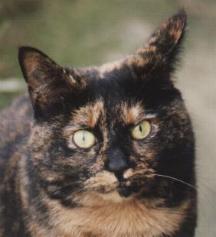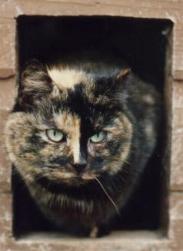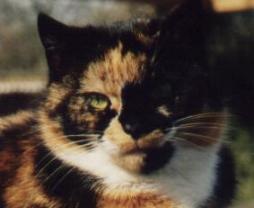


CALICO CONUNDRUM

AMSTERDAM -- It has been an established fact in cat breeding that tortoiseshell and calico cats are almost always female. This is because the orange (ginger to you and me) gene resides on the X chromosome. If a female gets two orange genes she is ginger; just one orange gene and she is a tortoiseshell (or calico if she has white bits). The male, on the other hand, only has one X chromosome and he is either ginger or not ginger. The rare tortie or calico male is a genetic or developmental anomaly and never breeds true. He might have inherited an extra X chromosome, making him a sterile XXY male, or he might be a chimera - the result of accidental fusion of two differently coloured embryos in the womb. At least one of those embryos - the one whose cells make the sexual organs - has to be a male. At least this has been an established fact until now.
ONE IN A MILLION
A study in the Netherlands has been taking tissue samples and arranging test matings of tortie and calico males to determine the frequency of natural chimeras. Put simply, Klinefelter males are infertile. The colour of offspring produced by chimera males depends on which embryo cells developed into the testes; the offspring will be ginger or black, but never tortie or calico. In April last year, a calico tom called Murfislaw seems to have bucked the trend. His offspring included both ginger and black kittens.
"That should have been impossible," said Dr Rina Roos, co-ordinator of the study, "The male has only one X chromosome so he should only be able to pass on ginger or black, but not both."
Dr Roos' initial theory was that the male was a chimera of a black-and-white embryo and a ginger-embryo and that his testicular tissue was a mix of cells from each of those.
"It was the only way he could make sperm that carried a mix of black genes and orange genes," she said, "if one testicle came from the orange embryo and the other came from the black embryo. It's a one-in-a-million happening."
With the owner's permission, she bred Murfislaw again. This time the unthinkable happened - the litter contained two calico tomcats. The next litter contained a tortoiseshell male. Somehow, Murfislaw was breeding true for tortoiseshell, something never before known in a male cat.
"We couldn't wait for those kittens to grow up!" said Roos, "We needed to mate them and see if they also bred true for tortoiseshell - and they did."
|
|
|
|
FELINE GENOME
Rather than produce dozens of potentially surplus kittens, Roos took her research to the cellular level. The publication of the feline genome helped her in this task.
"We found that the orange gene was on another chromosome and it should have been on the Y chromosome. Sometimes genes jump chromosomes and we know the Y chromosome is particularly prone to erosion. It is also co-dominant on that other chromosome. In some cells the orange gene is switched on and in some it is switched off."
The first of Murfislaw's fertile tortie and calico male offspring have already been homed to cat breeders eager to introduce the trait into established breeds. There is already a waiting list for more of his tortoiseshell male offspring.
CONTINUING CONTRIBUTION
Dr Roos summed up the discovery: "Right back to the early days of the cat fancy, tortoiseshell males were a curiosity. Frances Simpson wrote about them in 1903. More than a century later we have found true-breeding tortie males. It's great for cat fanciers, but it does reduce their novelty value." Back at his home in Belgium, Murflislaw is doing what comes naturally to a red-blooded tomcat, unaware of his continuing contribution to cat fancy history.
This is the Messybeast April Fool 2008. The only known line of tortie tomcats that produces more tortie tomcats is in Norwegian Forest Cats in Germany and has not yet been fully studied.